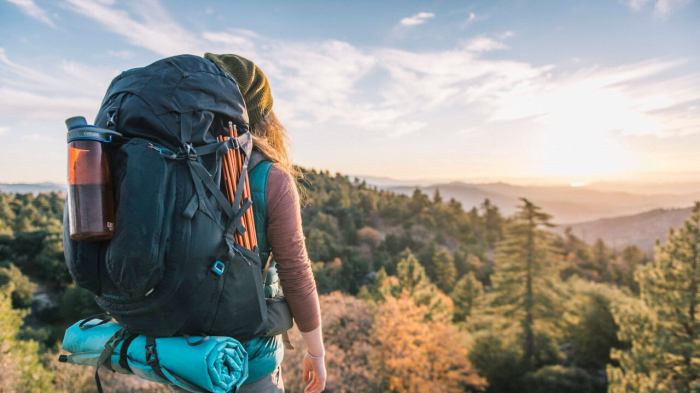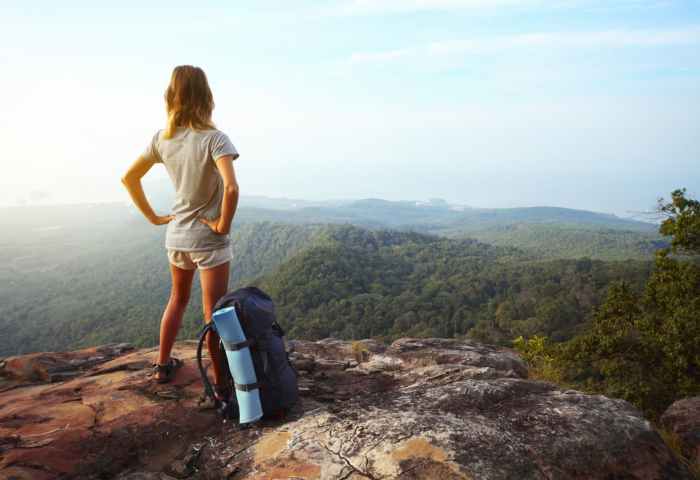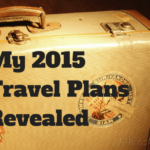Backpacking The World Alone is more than just a trip; it’s a transformative journey of self-discovery. This isn’t your typical vacation; it’s a deep dive into unfamiliar cultures, breathtaking landscapes, and the incredible resilience of the human spirit. We’ll explore everything from meticulously crafting your itinerary and budget to navigating unexpected challenges and capturing unforgettable memories. Get ready to unlock your inner adventurer.
This comprehensive guide will equip you with the practical knowledge and mental fortitude to conquer the logistical hurdles, embrace the cultural nuances, and ultimately, return home with a newfound appreciation for yourself and the world. We’ll delve into detailed budget planning, safety strategies for solo female travelers, and invaluable tips for overcoming homesickness and unexpected setbacks. Prepare to embark on the adventure of a lifetime.
Planning Your Solo Backpacking Trip
Embarking on a solo backpacking adventure requires meticulous planning to ensure a safe, enriching, and unforgettable experience. This involves crafting a realistic itinerary, packing strategically, understanding visa regulations, securing appropriate insurance, and choosing a travel style that aligns with your preferences and budget. Failing to properly plan can lead to unnecessary stress, unexpected expenses, and potentially compromise your safety.
Sample Three-Month Southeast Asia Backpacking Itinerary
This itinerary focuses on affordability and cultural immersion, prioritizing experiences over luxury accommodations. Adjust it based on your interests and available time. Costs are estimates and can vary based on your spending habits.
| Month | Location | Activities | Estimated Cost (USD) |
|---|---|---|---|
| 1 | Thailand (Bangkok, Chiang Mai, Krabi) | Explore temples, bustling markets, enjoy street food, island hopping | $1500 |
| 2 | Vietnam (Hanoi, Ha Long Bay, Hoi An) | Cycle through rice paddies, cruise Ha Long Bay, tailor-made clothing in Hoi An | $1200 |
| 3 | Laos (Luang Prabang, Vang Vieng) | Visit ancient temples, explore caves, relax by the Mekong River | $1000 |
Total Estimated Cost: $3700 (excluding international flights). This is a budget-conscious estimate; luxury travel could easily triple this figure.
Packing List for a Solo Female Backpacker (Six Months)
Packing light is crucial for solo female backpackers. Aim for a backpack weighing no more than 15-20kg (33-44lbs) to manage it easily. Prioritize versatile clothing items and consider safety features.
- Lightweight, quick-drying clothing (4-5 tops, 2-3 pairs of pants/skirts, 1 light jacket)
- Comfortable walking shoes and sandals
- Underwear and socks (sufficient for 1-2 weeks)
- Toiletries (travel-sized containers)
- First-aid kit (including anti-diarrheal medication, pain relievers, antiseptic wipes)
- Universal adapter
- Reusable water bottle
- Small padlock
- Copies of important documents (passport, visa, travel insurance)
- Money belt or hidden pouch
- Personal safety alarm
Remember to check the weather conditions of your destinations and adjust your packing list accordingly.
Visa Requirements and Travel Insurance for South America
Visa requirements vary significantly depending on your nationality and the countries you plan to visit in South America. Check the specific requirements for each country well in advance of your trip. Many countries offer tourist visas on arrival, but others may require pre-arranged visas. The website of the respective country’s embassy or consulate should be consulted for the most up-to-date information.Comprehensive travel insurance is essential for backpacking in South America.
It should cover medical emergencies, evacuation, lost luggage, and trip cancellations. Consider a policy that offers 24/7 emergency assistance. Research different providers and compare coverage options before making a decision. Ensure the policy adequately covers activities like trekking or adventure sports if you plan to participate in them.
Comparison of Backpacking Travel Styles
Backpacking styles cater to diverse preferences and budgets.
| Travel Style | Accommodation | Transportation | Activities | Estimated Daily Cost (USD) |
|---|---|---|---|---|
| Budget | Hostels, guesthouses | Buses, local trains | Free walking tours, budget-friendly activities | $30-50 |
| Mid-Range | Mid-range hotels, private rooms in hostels | Mix of buses and domestic flights | Variety of activities, including some guided tours | $75-150 |
| Luxury | Boutique hotels, high-end resorts | Private transfers, domestic flights | High-end activities, private guides | $200+ |
| Adventure | Camping, basic lodging | Hiking, cycling, kayaking | Challenging outdoor activities | $50-100 (excluding gear costs) |
The choice depends on your priorities and financial resources. Remember that even budget backpacking can be incredibly rewarding and offer unique experiences.
Cultural Immersion and Personal Growth
Solo backpacking presents a unique opportunity for profound cultural immersion and unparalleled personal growth. Stepping outside your comfort zone and into unfamiliar environments forces you to adapt, learn, and ultimately, discover a deeper understanding of yourself and the world around you. This isn’t just about ticking off destinations on a bucket list; it’s about forging meaningful connections, challenging preconceived notions, and expanding your worldview in ways that are simply impossible through traditional tourism.The challenges are undeniable.
Language barriers, cultural misunderstandings, and navigating unfamiliar social customs can be daunting. However, the rewards far outweigh the difficulties. The sheer act of overcoming these hurdles builds resilience, adaptability, and a newfound confidence in your ability to handle unexpected situations. This transformative experience extends beyond simply visiting new places; it’s about truly
living* in them, even temporarily.
Overcoming Cultural Barriers and Adapting to New Environments
Successfully navigating cultural differences requires a combination of preparation, open-mindedness, and a willingness to learn. For example, imagine arriving in a country where non-verbal communication plays a crucial role. Learning basic greetings and phrases in the local language can dramatically improve interactions, even if your fluency is limited. Observing the behavior of locals, paying attention to social cues, and respectfully following established norms demonstrates respect and fosters positive interactions.
A personal anecdote: During my travels in Japan, I initially struggled with the complex etiquette surrounding bowing. However, by observing others and practicing myself, I eventually became more comfortable and felt a greater sense of connection with the culture. This seemingly small act significantly improved my interactions and enriched my overall experience. Another instance involved adapting to the pace of life in a slower-paced Southeast Asian country.
Initially, the slower pace felt frustrating, but after embracing it, I found a sense of calm and presence I had never experienced before.
Respectful Engagement with Local Communities and Customs
Before embarking on your solo backpacking adventure, researching local customs and etiquette is paramount. This includes understanding appropriate dress codes, social norms, and religious practices. Showing respect for local traditions is crucial for building positive relationships with the community.
- Learn basic phrases in the local language. Even a simple “hello” and “thank you” can go a long way in showing respect.
- Be mindful of local customs and traditions. Research common practices beforehand to avoid unintentional offenses.
- Ask for permission before taking photographs of people, especially in sensitive situations.
- Support local businesses and artisans by purchasing their products and services.
- Be mindful of your environmental impact. Practice responsible tourism by reducing waste and respecting natural resources.
By following these guidelines, you not only demonstrate respect for the local culture but also enhance your travel experience, fostering genuine connections and creating lasting memories. These interactions, in turn, contribute significantly to personal growth and a deeper understanding of the world’s rich diversity.
Logistics and Transportation

Efficient and cost-effective transportation is the backbone of any successful backpacking adventure. Mastering this aspect allows you to maximize your time exploring and minimize unexpected setbacks. Understanding the various options available and planning accordingly will significantly enhance your overall experience.
Backpackers utilize a diverse range of transportation methods, each with its own advantages and disadvantages depending on your destination, budget, and travel style. The key is to adapt your approach to the specific context of your journey.
Modes of Transportation for Backpackers, Backpacking The World Alone
Choosing the right mode of transport is crucial for optimizing your backpacking experience. Consider factors such as cost, travel time, comfort, and the accessibility of your chosen method in your destination country. Different regions offer varying transportation infrastructures, so flexibility and adaptability are essential.
- Buses: Often the cheapest option, especially for longer distances. Buses provide a chance to observe local life and scenery. However, comfort levels can vary significantly, and journeys can be lengthy.
- Trains: Generally more comfortable than buses, and often faster for medium to long distances. Train travel offers scenic views and a more relaxed atmosphere. However, train travel can be more expensive than buses.
- Flights: Ideal for covering vast distances quickly, particularly across continents or countries separated by significant geographical barriers. Flights can be expensive, but budget airlines offer more affordable options. Remember to factor in airport transfer costs.
- Ride-Sharing Services (e.g., Uber, Grab): Convenient for shorter distances within cities and towns. These services offer a comfortable and safe way to navigate unfamiliar areas, but can be more expensive than public transport for longer journeys.
Navigating Public Transportation in Various Countries
Successfully navigating public transportation in foreign countries requires preparation and a willingness to embrace the unexpected. Familiarize yourself with local transportation systems before your trip, using online resources and apps.
- Learn basic local phrases: Knowing how to ask for directions or inquire about ticket prices can be incredibly helpful.
- Utilize transportation apps: Many apps provide real-time information on bus and train schedules, routes, and fares. Examples include Citymapper and Moovit.
- Purchase transit passes: Transit passes can often offer significant cost savings compared to purchasing individual tickets.
- Be aware of peak hours: Avoid traveling during peak hours if possible, as public transportation can be crowded and potentially uncomfortable.
- Study maps and routes in advance: Planning your routes beforehand can save you time and prevent confusion.
Booking Flights and Accommodation: Advance vs. On-the-Go
The decision of whether to book flights and accommodation in advance or on the go is a personal one, depending on your travel style and preferences. Both approaches have their advantages and disadvantages.
- Booking in advance: Secures your travel arrangements, allowing for better planning and often securing lower prices, especially for flights and popular accommodations. However, it reduces flexibility.
- Booking on the go: Offers greater flexibility and spontaneity, allowing you to adjust your itinerary based on your experiences and preferences. However, it increases the risk of higher prices and limited availability, especially during peak seasons.
Utilizing Ride-Sharing Apps and Other Transportation Options
Ride-sharing apps have revolutionized personal transportation, particularly in urban areas. However, their availability and reliability vary across different regions. Always research the most popular and reliable options in your destination.
- Local Alternatives: Be aware that many countries have their own versions of ride-sharing apps, such as Grab in Southeast Asia or Yandex Taxi in Russia. Research these local alternatives for better deals and potentially more convenient services.
- Safety Precautions: Always prioritize your safety. Share your ride details with a friend or family member, and stick to well-lit and populated areas when using ride-sharing services.
- Negotiating Fares: In some regions, negotiating fares with taxi drivers or tuk-tuk drivers is common practice. However, it’s essential to establish a fair price before starting your journey.
Overcoming Challenges and Building Resilience: Backpacking The World Alone

Solo backpacking, while incredibly rewarding, presents unique challenges. The freedom and adventure are often intertwined with moments of intense self-reliance and vulnerability. Understanding these challenges and developing strategies to overcome them is crucial for a positive and enriching experience. Building resilience isn’t just about surviving; it’s about thriving amidst the unexpected.
The journey of solo backpacking is a rollercoaster of emotions and experiences. While the highs are exhilarating, the lows can feel isolating and overwhelming. Successfully navigating these ups and downs requires proactive planning, mental fortitude, and a willingness to adapt. This section will equip you with the tools to not only manage difficulties but to emerge stronger and more self-aware.
Loneliness and Homesickness
Loneliness is a common challenge for solo travelers. The constant absence of familiar faces and routines can trigger feelings of isolation. Homesickness, a longing for the comfort and familiarity of home, can be equally intense. These feelings are perfectly normal and should not be dismissed.
Combatting loneliness requires proactive engagement. Connecting with fellow travelers in hostels, joining group activities, or even striking up conversations with locals can create a sense of community. Leveraging technology – video calls with loved ones, social media interactions – can help maintain connections back home. Scheduling regular “check-in” calls with family or friends can provide emotional support and reduce feelings of isolation.
Remember, actively combating loneliness is a conscious effort that yields significant positive returns.
Unexpected Setbacks and Adaptability
Unexpected setbacks – lost luggage, missed flights, illnesses, or even petty theft – are inevitable aspects of travel. The key is not to avoid them but to develop strategies to handle them effectively.
Flexibility and resourcefulness are paramount. Having backup plans, travel insurance, and a positive attitude can make a significant difference. For example, if your flight is canceled, explore alternative routes or accommodations. If your luggage is lost, prioritize essential items and utilize local resources to replace necessities. The ability to adapt and problem-solve on the fly is a skill honed through experience and proactive planning.
Consider learning basic phrases in the local language; this can greatly enhance your ability to navigate unexpected situations.
Maintaining Mental and Physical Well-being
Extended solo travel can take a toll on both mental and physical health. Maintaining a healthy lifestyle is crucial for preventing burnout and ensuring you enjoy your journey.
Prioritizing physical health involves regular exercise, a balanced diet, and sufficient sleep. Even simple activities like daily walks or yoga can significantly improve mood and energy levels. Finding healthy food options might require extra effort, but it’s an investment in your overall well-being. Adequate sleep is often overlooked, yet it’s fundamental for mental clarity and emotional regulation.
Furthermore, incorporating mindfulness practices, such as meditation or journaling, can help manage stress and promote mental well-being. These proactive steps will ensure you return home not only with amazing memories but also with a renewed sense of vitality.
Backpacking the world alone is a challenging yet incredibly rewarding experience. It pushes you beyond your comfort zone, forcing you to adapt, problem-solve, and connect with yourself and the world in ways you never thought possible. Remember, thorough planning, a proactive safety mindset, and a spirit of adventure are your greatest assets. So, pack your bags, embrace the unknown, and prepare for an unforgettable journey of self-discovery and global exploration.
The world awaits!

